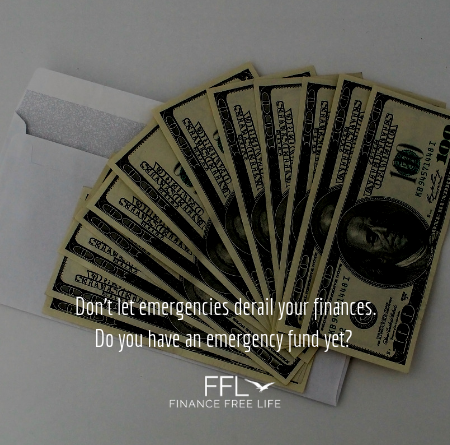Start an Emergency Fund
The foundation to any successful budget is a dedicated emergency fund. By starting with one, you can begin to break the cycle of insanity in your finances. Let’s talk about the why, and the how, of a successful emergency fund.
Why have an emergency fund?
Think about the last financial crisis you encountered. A broken dishwasher? Car tire blow out? House flooding? How did you handle that crisis? If you’re like the average American, you probably handled it with credit – put it on the credit card, take out a loan on the equity in your home, etc.
What if there was a better way? Imagine you had a small emergency fund, $1000 set aside during this crisis. How would things have gone differently for you? This is the main goal of an emergency fund. Rather than facing an emergency, using credit, then paying it off, only to face another emergency, having a dedicated fund can break that cycle.
Now let’s get into how to start an emergency fund.
1. Start with the budget.
The very first priority in developing an emergency fund is the budget. You must have a working budget in order to start this savings. The reason for this is you need to know how much money you have coming in and out each month.
From there, you can find ways to save extra money. The goal of the emergency fund is to save $1000 as fast as possible. By evaluating the budget, you can see how much excess there is each month.
2. Start saving.
Once you have a budget in place, you can start the emergency fund saving. Based on your workin budget, you should have a dedicated amount, either each month or each paycheck, which you can use to start adding to the fund each cycle. Maybe you determined there is $150 excess per month you can use towards building your savings. This breaks down to $75 per check. Starting with your next check, automatically move that $75 over to your savings. You can do this within the direct deposit, or as an automatic bank transfer.
3. Start pinching.
After you’ve evaluated the extra, you can start “pinching pennies” in your budget, paring down to the necessities. In addition to that, you can sell off unused items in your house, work additional hours at work for overtime, or even start a second job to bring in more income. These are all ways to go the extra mile in your savings. Without it, you’re looking at a minimum of 6 months to save that $1000. A lot of emergencies could happen in 6 months, so it’s important to work as fast as possible to get this fund in place.
There you have it – saving an emergency fund in 3 easy steps. What is stopping you from starting your fund? Or if you already have one, how did you get started? Let us know in the comments below.

